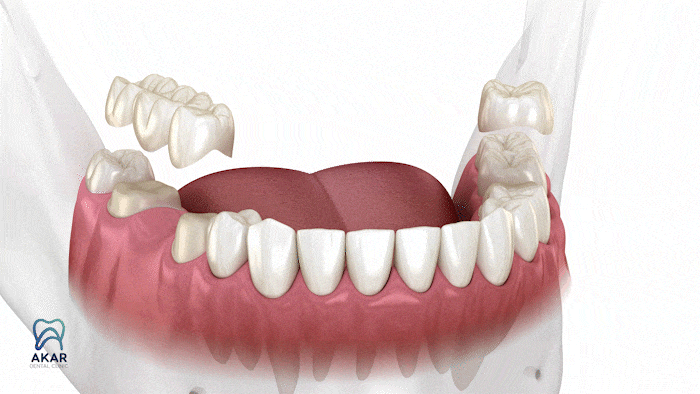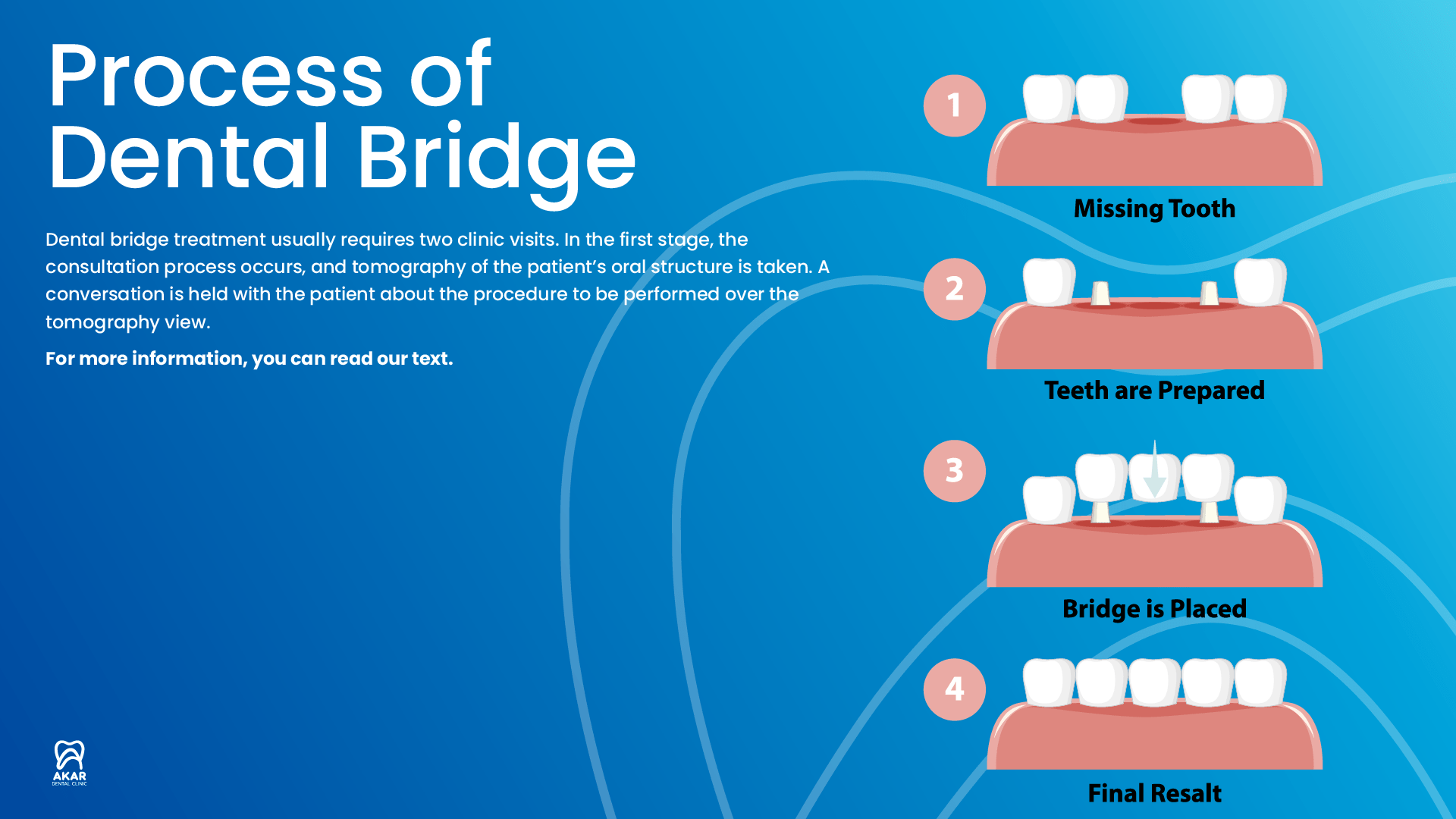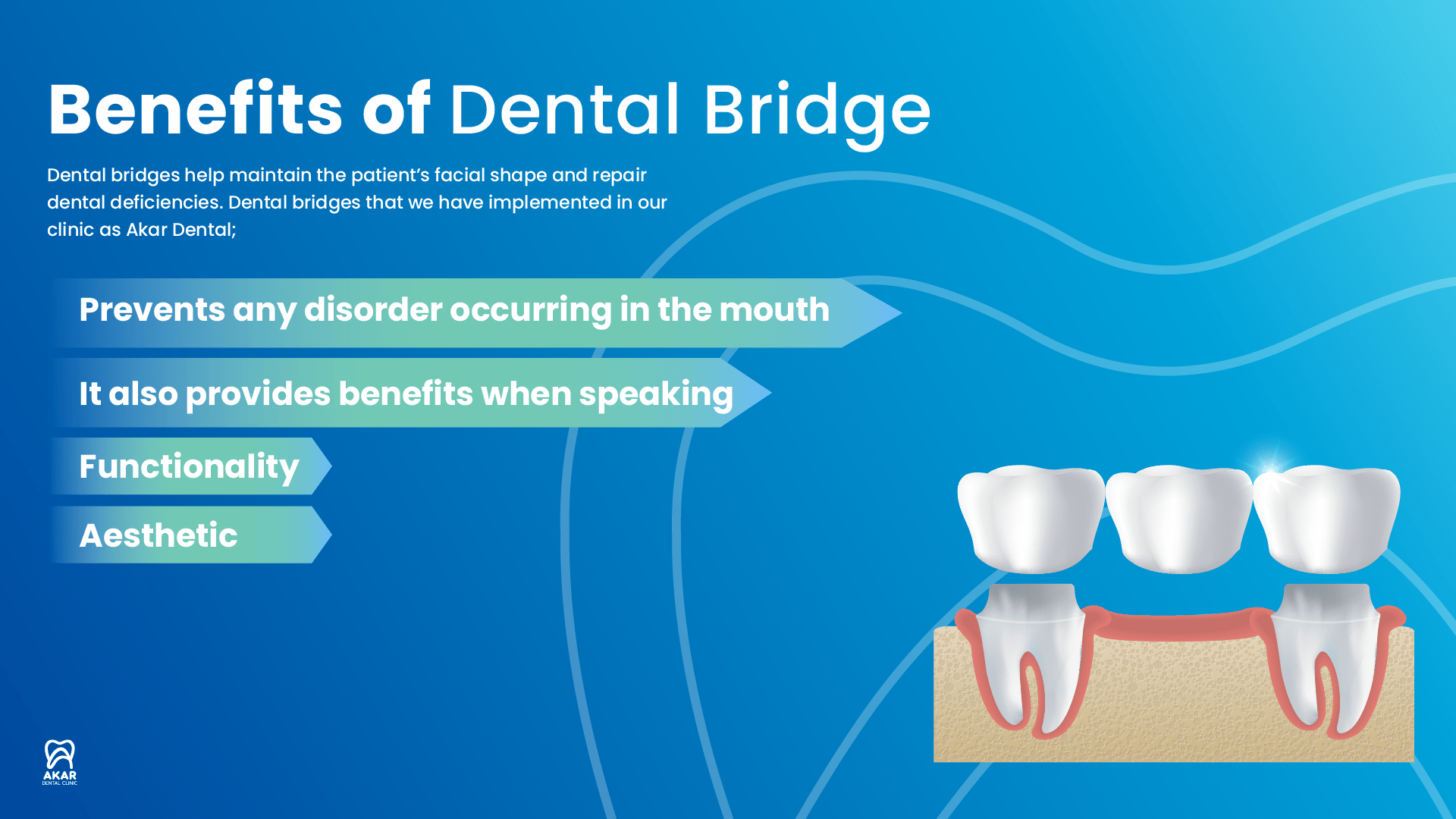

 Dental bridge treatment is one of the most commonly used treatments for correcting missing tooth defects. The patient receives a general examination from the dentist before the bridge dental procedure, and the dentist also takes an X-ray and a Dental Tomography of the patient to be able to examine the strong teeth condition which supports the dental bridge structure. During the examination, the dentist also gives attention to the dental bridge treatment by checking the patient’s jaw structure and determining the number of missing teeth and the locations of the gaps in the patient’s mouth.
Dental bridge treatment is one of the most commonly used treatments for correcting missing tooth defects. The patient receives a general examination from the dentist before the bridge dental procedure, and the dentist also takes an X-ray and a Dental Tomography of the patient to be able to examine the strong teeth condition which supports the dental bridge structure. During the examination, the dentist also gives attention to the dental bridge treatment by checking the patient’s jaw structure and determining the number of missing teeth and the locations of the gaps in the patient’s mouth.
“What is a dental bridge?” is one of the most frequently asked questions concerning this topic. Dental Bridge is treatment eliminating aesthetic concerns for individuals who have missing one or more than one tooth.The bridge including crowns is attached to the strong teeth on either side of the gap. Dental bridge is a treatment solution which may be an alternative to the implants. The crowns in bridge treatment can be made of zirconium, porcelain or porcelain fused to metal (PFM). In addition, dental bridge solutions may be also applied to the implants. Dental bridge front tooth crown is also possible for patients who have aesthetic concerns. Dental bridge treatment is one of the traditional treatment methods for tooth loss for a long time.
What is Dental Bridge?
 There are various methods of filling the gaps formed in the tooth, and a dental bridge is one of the most commonly preferred methods. Bridge dental practice is evaluated according to the preference of the patient and according to the suitability of the mouth, durability of other teeth and bone structure. Dental bridges are generally recommended for patients whose oral structure is unsuitable for implants or those who would not like to have an implant, so the decision which is related to treatment depends on patients’ preference.
There are various methods of filling the gaps formed in the tooth, and a dental bridge is one of the most commonly preferred methods. Bridge dental practice is evaluated according to the preference of the patient and according to the suitability of the mouth, durability of other teeth and bone structure. Dental bridges are generally recommended for patients whose oral structure is unsuitable for implants or those who would not like to have an implant, so the decision which is related to treatment depends on patients’ preference.
Especially in patients with multiple tooth loss, formal disorders in the anatomy of the face or jaw and difficulty in speaking action may occur over the time due to these types of complications. For this reason, filling the gaps due to tooth loss is very important. The deficiency in the patient’s teeth may cause the existing teeth to move toward the cavity caused by the missing tooth. As a result of this situation, various difficulties or asymmetric disorders may occur in situations such as chewing, jaw opening, and closing actions. The dental bridge ensures that these situations are prevented.
Types of Dental Bridge
 Types of dental bridges are designed to match the oral structures of patients, and for this reason, there are four types of treatment solutions which are determined according to how many missing teeth related area needs and location of the area in the mouth, such as front dental bridges or molar dental bridges.
Types of dental bridges are designed to match the oral structures of patients, and for this reason, there are four types of treatment solutions which are determined according to how many missing teeth related area needs and location of the area in the mouth, such as front dental bridges or molar dental bridges.
-
Cantilever Dental Bridges
The pontic on the dental bridge is held in place only by a dental crown affixed to the fulcrum tooth. A cantilever bridge requires only one natural tooth adjacent to the missing tooth gap. Cantilever Dental Bridge may be a solution for individuals who have just one missing tooth area in their mouth.
-
Maryland Dental Bridges
The Maryland bridge type is performed by gluing the bridge to neighboring teeth. A tooth prepared to fill a dental cavity is glued to the back of neighboring teeth right next to the cavity. The Maryland Bridge dental prosthesis method, applied in our clinic, is preferred, especially as a procedure performed without cutting healthy teeth. On the other hand, the version applied by the gluing method is less efficient in terms of durability.
-
Common Dental Bridges
A popular (Traditional) dental bridge procedure uses a “bridge foot” to attach the healthy teeth to the bridge on the right and left side of the missing teeth by rasping and reducing them. The constructed bridge dental prosthesis is then fitted over the permanent teeth. This is one of the most regularly utilized procedures in treating dental bridges for individuals who have more than one missing tooth area in their mouth.
-
Implant-Supported Dental Bridges
Implant-supported bridges are generally preferred in cases with more than one tooth loss, when the patients do not have the strong teeth which the missing area can not be supported. The implant-supported bridge applied in our clinic is a method that, just like the Maryland winged bridge type, does not reveal the need to cut healthy teeth and can be applied without cutting. This method is preferred in patients with suitable jaw bone structures. In the case of multiple tooth loss, an implant bridge screwed to the jawbone replaces the missing teeth.
Our specialist doctors in bridge dental treatment examine the patient’s mouth, teeth, and jaw structure, and select the most suitable one. We provide dental bridge treatment depending on the patient’s anatomical structure and wishes.
Process of Dental Bridge
 Dental bridge treatment usually requires two clinic visits. In the first stage, the consultation process occurs, and tomography of the patient’s oral structure is taken. A conversation is held with the patient about the procedure to be performed over the tomography view.
Dental bridge treatment usually requires two clinic visits. In the first stage, the consultation process occurs, and tomography of the patient’s oral structure is taken. A conversation is held with the patient about the procedure to be performed over the tomography view.
-
Consultation
The patient’s dental tomography is taken depending on the dental bridge procedure. This process will determine where the bridge will be applied more easily. At this stage, the patient’s history is taken, and, if necessary, other forms of treatment are also discussed.
-
Preparation of the Dental Crowns
For bridge types other than Maryland Dental treatment, dental crowns need to be prepared to fill the missing area. Firstly, the teeth that will be taken as the support for missing areas to be able to hold, are shaved for the crown placement onto patients’ own teeth. This area is determined by using the X-ray or Tomography imaging taken to check the durability of supporting teeth. Usually, part of the dentin is removed, and temporary dental crowns are placed to prevent any sensitivity occurring until the permanent dental crowns are prepared.
-
Placement of Permanent Bridge – Second Visit
The harmony of the area prepared at the previous visit is checked with the permanent bridge prepared by removing the patient’s temporary crowns. At the same time, attention is also paid to the harmony of the prepared permanent crown in terms of color and functionality, which is presented to the patient’s liking. If the crowns are not liked, a new one is prepared, and thus dental bridge service is provided for the patients in our clinic in the best possible way. By choosing our clinic, you can have your treatment away from the symptoms of an ill-fitting dental bridge.
After the permanent bridge is put in place, the patient is informed about post-procedure and bridge dental care.
Who Needs a Dental Bridge?
When you experience tooth loss, this condition can negatively affect you. A dental bridge benefits patients in the following situations:
- Correction of smile
- Lack of ability to chew properly
- Difficulty with your speech and pronunciation
- Deformation of the shape of your face due to teeth
- Problems with the act of chewing
- Aesthetic Concerns
Dental bridge treatment may be a solution to your complaints and concerns listed above. In addition, gums are always inclined to move towards any missing area in the mouth, that means the missing area offers an opinion to be treated as quickly as possible.
Benefits of Dental Bridge
 Dental bridges help maintain the patient’s facial shape and repair dental deficiencies. Dental bridges that we have implemented in our clinic as Akar Dental;
Dental bridges help maintain the patient’s facial shape and repair dental deficiencies. Dental bridges that we have implemented in our clinic as Akar Dental;
- Aesthetic
- Functionality
- It also provides benefits when speaking
- Prevents any disorder occurring in the mouth
Dental bridges help our patients get their old smiles back by treating deformities due to a tooth in the form of a face. The difficulties experienced in chewing due to tooth loss are eliminated with dental bridge treatment because the gaps between the teeth disappear.
Pronunciation and reading of letters in speaking are directly related to the teeth. Correcting the gaps between the teeth and restoring the dental forms to their old and healthy form makes it possible to overcome speech difficulties. In addition, dental bridges prevent other teeth from shifting, preventing other tooth damage that may occur.
Dental Bridge Before and After
The dental bridge before and after can be explained by starting from the before stage. Before the Dental Bridge procedure, problems may be observed in the following areas in patients:
- Difficulty in chewing
- Difficulty in speaking
- Self-confidence problems with laughter
- Growth and development of teeth with incorrect positioning
 After the dental bridge procedure, the gaps in the teeth are eliminated, and the possibility of shifting in other teeth is prevented. Problems caused by the positioning of the teeth and disorders in facial expressions change, after the patient has undergone treatment. After dental bridge treatment, patients begin to speak fluently and pronounce words correctly. On the other hand, functionality of their bridges also treats the past chewing problems. In addition, because they get a more aesthetic appearance in terms of the smile, self-confidence problems caused by teeth are prevented.
After the dental bridge procedure, the gaps in the teeth are eliminated, and the possibility of shifting in other teeth is prevented. Problems caused by the positioning of the teeth and disorders in facial expressions change, after the patient has undergone treatment. After dental bridge treatment, patients begin to speak fluently and pronounce words correctly. On the other hand, functionality of their bridges also treats the past chewing problems. In addition, because they get a more aesthetic appearance in terms of the smile, self-confidence problems caused by teeth are prevented.
Why Choose Turkey for Dental Bridge?
Dental operations provided in Turkey are very attractive in terms of budget and quality. As Akar Dental, we provide services to people who want to get a dental operation in Turkey. Thanks to our advanced Tomography, X-ray and computer-aided systems, we carefully produce and provide everything necessary for dental bridges or other dental treatments.
In our clinic in Antalya, we also provide various opportunities for our patients who have dental bridge treatment in terms of accommodation. We ensure that a high-level dental bridge treatment is crowned with holiday opportunities.
The dental bridge procedure is a treatment method that is easier to prepare than implants, and the healing process is easier. Implant application is not performed if the patient’s health condition can be corrected with a dental bridge.
From an aesthetic point of view, the dental bridge, which is in harmony with other teeth due to its color, performs close to the normal tooth appearance.
You must make 2 clinic visits that can be completed 2-4 days in a week for your dental bridge treatment in Antalya. On average, the entire treatment is completed 2-4 days with 2 clinic visit.
The patient does not feel pain during dental bridge treatment because anesthesia is applied.
Dental bridge cleaning can be performed with mouthwash, tooth brushing, and flossing.
You can contact us to get more information about our oral and dental health treatments and the opportunities we offer.